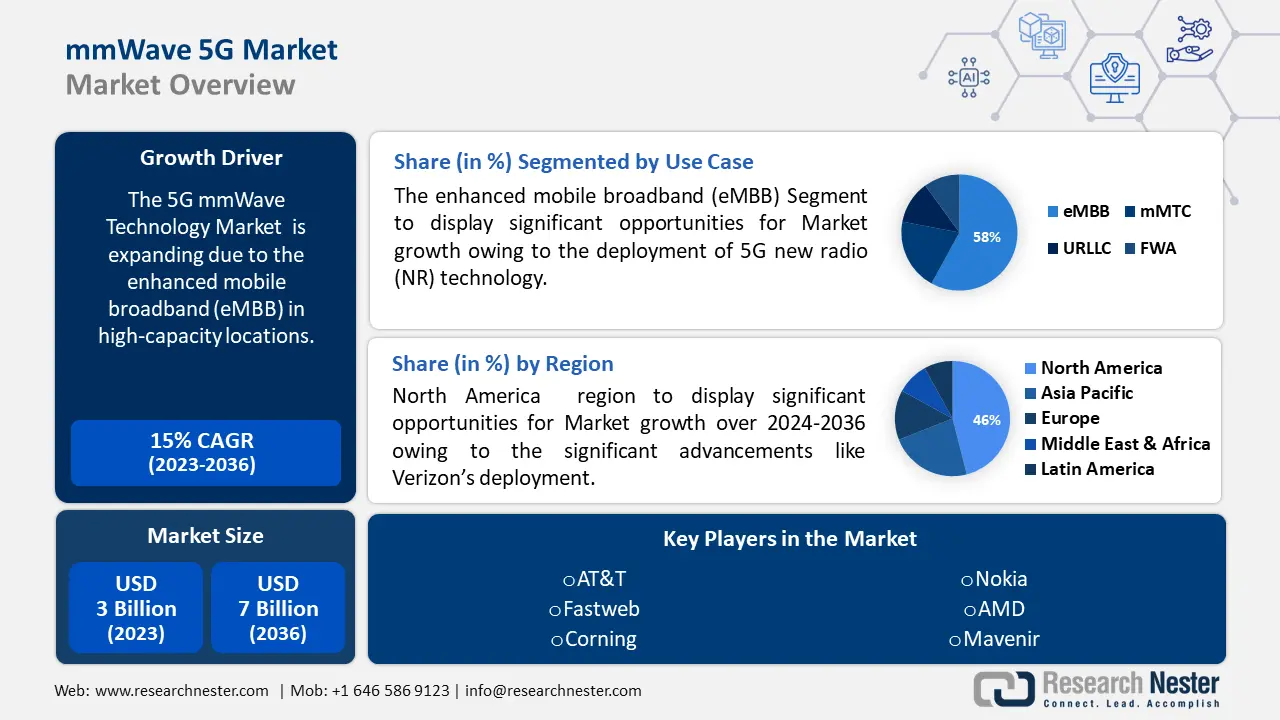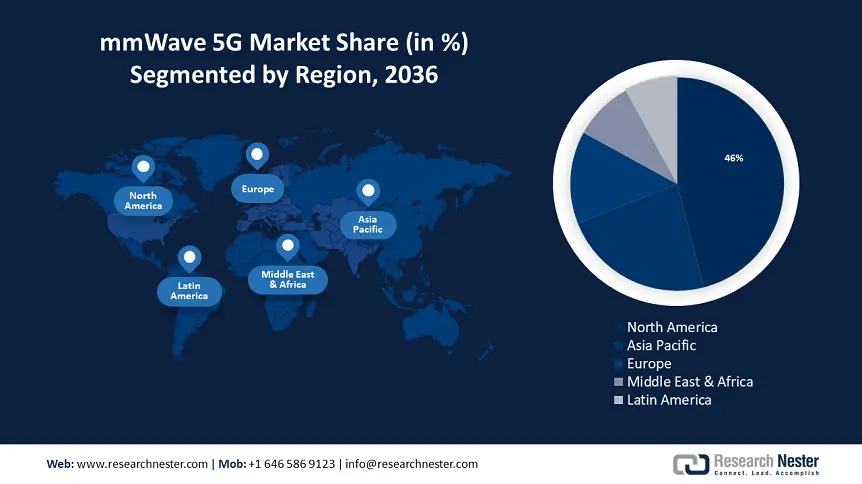
mmWave 5G Market size is poised to reach USD 7 Billion by the end of 2036, growing at a CAGR of 15% during the forecast period, i.e., 2024-2036. In the year 2023, the industry size of mmWave 5G was USD 3 Billion. The enhanced mobile broadband (eMBB) in high-capacity locations is extensively used as the primary boosting factor for the market owing to its proficiency in handling large data transfers efficiently and maintaining high amidst network congestion. Sectoral growth is propelled by a robust increase in global mobile service revenues, which saw a rise of approximately 15% between 2020 and 2023, or about 4.6% annually. This technology is pivotal in areas such as airports and concerts, where demand for connectivity without speed degradation is critical.
In addition to these, factors that are believed to fuel the market growth of the market include enhanced last-mile connectivity solutions and mmWave’s seamless service delivery. eMBB’s advancements in high-density areas support diverse applications, from HD streaming to cloud services boosting sectoral expansion in urban centers.

Growth Drivers
Challenges
|
Base Year |
2023 |
|
Forecast Year |
2024-2036 |
|
CAGR |
~15% |
|
Base Year Market Size (2023) |
~ USD 3 Billion |
|
Forecast Year Market Size (2036) |
~ USD 7 Billion |
|
Regional Scope |
|
Use Case (eMBB, mMTC, URLLC, FWA)
The eMBB segment in the mmWave 5G market is estimated to gain a significant share of about 58% in the year 2036. The segment growth can be attributed to the deployment of 5G new radio (NR) technology, which focuses on operating across higher frequency bands between 410 MHz-7125 MHz or 24250 MHz-52600MHz. This initiative is set to provide wired-like performance and reliability, a strategic move to support the burgeoning influx of new devices and applications that demand extensive bandwidth. eMBB leverages these capabilities of 5G NR to ensure fast and reliable mobile broadband services. Such advancements are crucial for facilitating cutting-edge applications, including augmented reality (AR), virtual reality (VR), and 4K media, that are rapidly gaining prominence.
Application (Augmented Reality-Virtual Reality, Internet of things solutions, Connected Vehicles, Autonomous Driving, Telemedicine, Remote Healthcare)
The AR/VR segment in the mmWave 5G market is estimated to gain a significant share of about 52% in the year 2036, riding on the back of 5G technology, which promises to revolutionize the user experience in augmented and virtual reality. This surge is directly linked to mmWave’s 5G capability to deliver expansive bandwidth with minimal latency ensuring that data transfers easily between devices. Such technological strides are essential for seamless AR and VR content without jitters and disruptions are pivotal, making mmWave 5G a cornerstone of AR/VR sectoral growth.
Our in-depth analysis of the global market includes the following segments:
|
Product |
|
|
Application |
|
|
Use Case |
|
North American Market Forecast
mmWave 5G market in North America is anticipated to hold the largest share of about 46% by the end of 2036. The market growth in the region is expected on account of significant advancements like Verizon’s deployment of over 130,000 O-RAN capable radios, including massive MIMO units, across 15,000 virtualized sites. Verizons strategic acquisition of Verena networks enhances their trajectory in resolving mmWave 5G challenges, contributing to expansive network growth. Verena’s platform mitigates the need for separate wired backhauls by integrating access and backhaul in a single mmWave antenna, streamlining installations, and solidifying North America’s leadership in the global 5G landscape.
APAC Market Analysis
The Asia Pacific mmWave 5G market is estimated to be the second largest, share of about 23% by the end of 2036. The market’s expansion can be attributed majorly to the evolving regulatory framework that supports 5G advancements. For instance, Qualcomm technologies incorporation, achieved a milestone with its 5G standalone (SA) mmWave performance, facilitating wider commercial mmWave deployment. With the global internet user base expanding, 5G SA mmWave is set to unlock new capabilities for more sectors and users. The Qualcomm snapdragon X65 5G modern-RF systems demonstrated its prowess by achieving over 7.1 Gbps download speed and 2.1 Gbps upload speed in tests conducted with ZTE, nokia shanghai bell, and CICT mobile’s network infrastructure, guided by China Academy of Information and Communication Technology (CAICT) and China’s IMT-2020 5G promotion group.



Author Credits: Abhishek Verma, Hetal Singh
Copyright © 2024 Research Nester. All Rights Reserved

FREE Sample Copy includes market overview, growth trends, statistical charts & tables, forecast estimates, and much more.
Have questions before ordering this report?